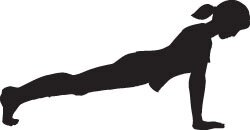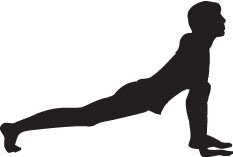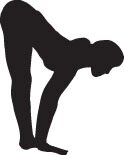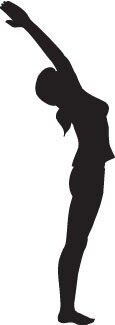Training
The sun salutation, or surya namaskar (Sanskrit), is a dynamic sequence of movements (asana) performed to celebrate the sun, while building strength and improving flexibility.
Position 1: Pranamasana (Prayer Pose)
Keep the eyes closed.
Remain standing upright with the feet together.
Slowly bend the elbows and place the palms together in front of the chest in prayer position, mentally offering homage to the sun, the source of all life.
Relax the whole body.
Breathing: Breathe normally
Benefits: This pose establishes a state of concentration and calmness in preparation for the practice to be performed.
Position 2: Hasta Utthanasana (Raised Arms Pose)
Raise and stretch both arms above the head.
Keep the arms separated, shoulder width apart.
Bend the head, arms and upper trunk backward.
Breathing: Inhale while raising the arms.
Benefits: This pose stretches all the abdominal organs and improves digestion. It exercises the arm and shoulder muscles, tones the spinal nerves, opens the lungs and removes excess weight.
Position 3: Padahastasana (Hand To Foot Pose)
Bend forward until the fingers or palms of the hands touch the floor on either side of the feet.
Try and touch the knees with the forehead.
Do not strain.
Keep the knees straight.
Breathing: Exhale while bending forward. Try to contract the abdomen in the final position to expel the maximum amount of air from the lungs.
Benefits: This pose is useful in eliminating or preventing stomach or abdominal ailments. It reduces excess weight in the abdominal region, improves digestion and helps to remove constipation. It improves blood circulation, makes the spine supple and tones the spinal nerves.

Position 4: Ashwa Sanchalanasana (Equestrian Pose)
Place the palms of the hands flat on the floor beside the feet.
Stretch the right leg back as far as possible.
At the same time, bend the left knee, keeping the left foot on the floor in the same position. Keep the arms straight. In the final position, the weight of the body should be supported on both hands, the left foot, right knee and toes of the right foot. The head should be tilted backward, the back arched and the inner gaze directed upward to the eyebrow centre.
Breathing: Inhale while stretching the right leg back.
Benefits: This pose massages the abdominal organs and improves their functioning, strengthens the leg muscles and induces balance in the nervous system.
Practice note: In the final pose the palms of the hands should be flat on the floor initially. Later on, more advanced practitioners may come up onto the fingertips.

Position 5: Dandasana (Inclined Pose)
Assume the push-up position. Place the palms of the hands on the floor beneath the shoulders.Your body should be in a straight line. Focus your gaze on a fixed point at eye level. Hold the position for a short duration.
Breathing: Hold your breath in this position for as long as it is comfortable.
Benefits: This asana improves nervous balance and develops a sense of inner equilibrium and harmony. It strengthens the muscles of the arms, shoulders and spine, and balances the interaction between the dorsal and ventral muscles.

Position 6: Ashtanga Namaskara (Salute With Eight Parts)
Lower the knees, chest and chin to the floor.
In the final position only the toes, knees, chest, hands and chin touch the floor. The knees, chest and chin should touch the floor simultaneously. If this is not possible, first lower the knees, then the chest, and finally the chin.
The buttocks, hips and abdomen should be raised.
Breathing: The breath is held outside in this pose. There is no respiration.
Benefits: This pose strengthens the leg and arm muscles, develops the chest and exercises the region of the spine between the shoulder blades.

Position 7: Bhujangasana (Cobra Pose)
Lower the buttocks and hips to the floor, straightening the elbows, arch the back and push the chest forward into the cobra pose.
Bend the head back and direct the gaze upward to the eyebrow centre.
The thighs and hips remain on the floor and the arms support the trunk.
Unless the spine is very flexible the arms will remain slightly bend.
Breathing: Inhale while raising the torso and arching the back.
Benefits: This pose keeps the spine supple, improving circulation in the back region and toning the spinal nerves. It tones the reproductive organs, stimulates digestion and relieves constipation. It also tones the liver and massages the kidneys and adrenal glands.

Position 8: Parvatasana (Mountain Pose)
From bhujangasana assume parvatasana.
The hands and feet do not move from position 7.
Breathing: Exhale while raising the buttocks.
Benefits: This pose strengthens the nerves and muscles in the arms and legs. The spinal nerves are toned and circulation is stimulated especially in the upper spine, between the shoulder blades.

Position 9: Ashwa Sanchalanasana (Equestrian Pose)
This stage is the same as position 4.
Keep the palms flat on the floor.
Bend the left leg and bring the left foot forward between the hands.
Simultaneously, lower the right knee so that it touches the floor and push the pelvis forward.
Tilt the head backward, arch the back and gaze at the eyebrow centre.
Breathing: Inhale while assuming the pose.
Benefits: This pose massages the abdominal organs and improves their functioning, strengthens the leg muscles and induces balance in the nervous system.
Practice note: In the final pose the palms of the hands should be flat on the floor initially. Later on, more advanced practitioners may come up onto the fingertips.

Position 10: Padahastasana (Hand to Foot Pose)
This position is a repetition of position 3.
Bring the right foot forward next to the left foot.
Straighten both knees.
Bring the forehead as close to the knees as possible without straining.
Breathing: Exhale while performing the movement.
Benefits: This pose is useful in eliminating or preventing stomach or abdominal ailments. It reduces excess weight in the abdominal region, improves digestion and helps to remove constipation. It improves blood circulation, makes the spine supple and tones the spinal nerves.

Position 11: Hasta Utthanasana (Raised Arms Pose)
This position is a repetition of position 2.
Raise the torso and stretch the arms above the head.
Keep the arms separated, shoulder width apart.
Bend the head, arms and upper trunk backward.
Breathing: Inhale while straightening the body.
Benefits: This pose stretches all the abdominal organs and improves digestion. It exercises the arm and shoulder muscles, tones the spinal nerves, opens the lungs and removes excess weight.
Position 12: Pranamasana (Prayer Pose)
This is the final position and is the same as position 1.
Bring the palms together in front of the chest.
Breathing: Exhale while assuming the final position.
Benefits: This pose establishes a state of concentration and calmness.
Positions 13 – 24
The twelve positions of Surya Namaskara are practiced twice to complete one round. Positions 1 to 12 constitute half a round. In the second half, the positions are repeated with two small changes:
1) In position 16, instead of stretching the right foot backward, stretch the left foot back.
2) In position 21, bend the right leg and bring the right food between the hands.
After completing surya namaskara, practice shavasana (corpse pose) for a few minutes. Spread the legs one to two feet apart, the toes are turned outwards, the heels facing each other, a comfortable distance apart. Bring the arms a little away from the body, palms turned upward.
This will allow the heartbeat and respiration to return to normal and all the muscles to relax. After the exertions of the practice, Shavasana allows the body a chance to regroup and reset itself. After a balanced practice, the entire body will have been stretched, contracted, twisted and inverted. These means that even the deepest muscles will have the opportunity to let go and shed their regular habits, if only for a few minutes.








